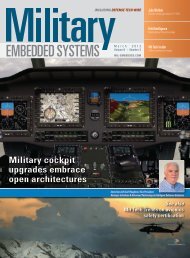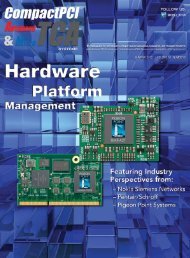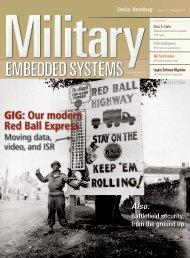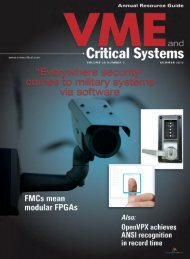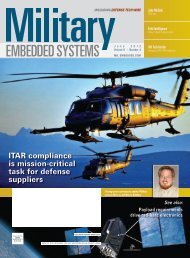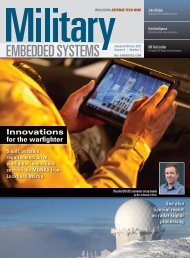Technologic - OpenSystems Media
Technologic - OpenSystems Media
Technologic - OpenSystems Media
- No tags were found...
You also want an ePaper? Increase the reach of your titles
YUMPU automatically turns print PDFs into web optimized ePapers that Google loves.
A 1.66GHz Intel®Atom TMIndustrial SBC ofEPIC ProportionsFanlessExtendedTemperatureAll-in-0neSingle BoardComputerIndustrial-gradeCFlash targeted forhigh-enduranceapplications.
The EPX-C380 is a rugged single board computerthat provides an open powerful platform forindustrial applications.Powered with either a single or dual core processor, it has a wealth of onboardI/O plus expansion options. Also it supports Linux, Windows® XP embedded,and other x86 real-time operating systems.Features include:• 1.66GHz Intel® Atom N450 single core or D510 dual core processor• Embedded Gen 3.5+ GFX video core supports CRT and LVDS flat panelssimultaneously• Custom splash screen on start up• Optional 1MB of battery backed SRAM• Two, Gigabit Ethernet ports• Two SATA channels• Eight USB 2.0 ports each with over current protection• Four serial RS-232/422/485 channels• 48 bi-directional digital I/O lines• CompactFlash (CF) card supported• MiniPCIe and PC/104-Plus expansion connectors• High Definition audio supported (7.1)• WDT, RTC, LPT, status LEDs, and beeper• +5 volt only operation• EPIC sized: 4.5” x 6.5” and RoHS compliant• EBX sized SBC also available• Extended temperature operation• Responsive and knowledgeable technical support• Long-term product availability• Quick Start Kits for software developmentContact us for additional information, custom configurations, and pricing.Our factory application engineers look forward to working with you.Call 817-274-7553 or Visitwww.winsystems.com/EPX-C380EAsk about our 30-day product evaluation715 Stadium Drive • Arlington, Texas 76011Phone 817-274-7553 • FAX 817-548-1358E-mail: info@winsystems.comEMBEDDED PCS GPS MODULES COMPACT FLASH SUMIT PANEL PCS I/O MODULES ENCLOSURES SBCS
STACKEDIN YOURFAVORACCELERATE YOUR EMBEDDEDGRAPHICS DELIVERY WITHPRE-INTEGRATED SOFTWAREDEVELOPING GRAPHICS ON-TIME ANDON-BUDGET IS KEY FOR MISSION ANDSAFETY CRITICAL AVIONICS. PRESAGISOFF-THE-SHELF SOFTWARE HELPS YOUCOMPLY WITH STANDARDS AND SPEEDSDEVELOPMENT OF THE EMBEDDED DISPLAYSTACK FOR DELIVERY OF NEXT GENERATIONFIXED OR ROTARY WING COCKPIT AVIONICS.VAPS XT, THE LEADING SOFTWARE FOR RAPIDLYDEVELOPING HMI, HAS BEEN CERTIFIED ON MAJORAIRCRAFT WORLDWIDE. ENGINEERED FOR SAFETY,PERFORMANCE AND CERTIFICATION, SEAWEED SEAWINDDRIVERS FROM PRESAGIS ARE ALSO AIRBORNE ANDSUPPORT A WIDE RANGE OF GPUS.LEARN MORE AT WWW.PRESAGIS.COM/EGOR CALL +1-800-361-6424 | +1-514-341-3874© 2011 Presagis TM Canada Inc. and/or Presagis TM USA Inc. All rights reserved.Presagis, the Presagis logo, Seaweed, SeaWind, and VAPS XT are either registered trademarks or trademarks of Presagisin Canada and/or other countries. All other trademarks contained herein are the property of their respective owners.
Advertiser InformationPageAdvertiser/Ad title14 Advantech Embedded Group –Next generation Intel Atom processor(code named Cedar Trail)32 Annapolis Micro Systems, Inc. – Highperformance signal and data processing27 ATP Electronics – ATP industrial gradeflash products and DRAM modules15 Elma Electronic – Even the smallestdetail matters24 EMAC, Inc. – Low cost panel PC31 Embedded World – We are the future23 Interface Concept – Switches andIP routers17 LiPPERT Embedded Computers –One source for all COM needs25 Memoright Memoritech (Shenzhen)Co., Ltd. – Customized solutionsand support for military and industrystorage applications13 Pentek, Inc. – High-speed, real-timerecording systems5 Presagis – Stacked in your favor10 Sunrich Technology – The bestconnection19 Supermicro – Embedded building blocks9 <strong>Technologic</strong> Systems – TS-WIFIBOX-229 Vector Electronics & Technology, Inc. –VectorPak systems packaging2, 3 WinSystems, Inc. – A 1.66 GHz IntelAtom industrial SBC of EPIC proportions11 X-ES – Frustrated by delays?ECD Editorial/Production StaffWarren Webb, Editorial Directorwwebb@opensystemsmedia.comJennifer Hesse, Managing Editorjhesse@opensystemsmedia.comSales GroupPatrick HopperVice President Marketing & Salesphopper@opensystemsmedia.comDennis DoyleSenior Account Managerddoyle@opensystemsmedia.comTom VarcieSenior Account Managertvarcie@opensystemsmedia.comRebecca BarkerStrategic Account Managerrbarker@opensystemsmedia.comEric HenryStrategic Account Managerehenry@opensystemsmedia.comChristine LongOnline Managerclong@opensystemsmedia.comBrandon Lewis, Associate Editorblewis@opensystemsmedia.comSteph Sweet, Creative Directorssweet@opensystemsmedia.comInternational SalesElvi LeeAccount Manager – Asiaelvi@aceforum.com.twRegional Sales ManagersBarbara Quinlan, Midwest/Southwestbquinlan@opensystemsmedia.comDenis Seger, Southern Californiadseger@opensystemsmedia.comSydele Starr, Northern Californiasstarr@opensystemsmedia.comRon Taylor, East Coast/Mid Atlanticrtaylor@opensystemsmedia.comReprints and PDFsNan Holliday800-259-0470republish@opensystemsmedia.com<strong>OpenSystems</strong> <strong>Media</strong> Editorial/Production StaffReader ResourcesSubscribe to magazines and E-letters:www.opensystemsmedia.com/subscriptionsE-casts:ecast.opensystemsmedia.comTechChannels:tech.opensystemsmedia.comWhite Papers:whitepapers.opensystemsmedia.comVideos:video.opensystemsmedia.comGet news via RSS:www.embedded-computing.com/news/rss.xmlAdvertiser ResourcesSubmit information:submit.opensystemsmedia.com<strong>Media</strong> kits:www.opensystemsmedia.com/publicationsJoin the DiscussionFacebook: www.facebook.com/Embedded.Computing.DesignTwitter: @embedded_magLinkedIn: www.linkedin.com/groups?gid=1802681Rosemary KristoffVice President EditorialMike Demler, Editorial DirectorDSP-FPGA.commdemler@opensystemsmedia.comJoe Pavlat, Editorial DirectorCompactPCI, AdvancedTCA,& MicroTCA Systemsjpavlat@opensystemsmedia.comJerry Gipper, Editorial DirectorVME and Critical Systemsjgipper@opensystemsmedia.comJohn McHale, Editorial DirectorMilitary Embedded Systemsjmchale@opensystemsmedia.comSharon Hess, Managing EditorMilitary Embedded SystemsVME and Critical Systemssharon_hess@opensystemsmedia.comEditorial/Business Office16626 E. Avenue of the Fountains, Ste. 201Fountain Hills, AZ 85268Tel: 480-967-5581 n Fax: 480-837-6466Website: www.opensystemsmedia.comPublishers: John Black, Michael Hopper,Wayne KristoffMonique DeVoeAssistant Managing EditorPC/104 and Small Form FactorsDSP-FPGA.commdevoe@opensystemsmedia.comBrandon LewisAssociate EditorCompactPCI, AdvancedTCA,& MicroTCA Systemsblewis@opensystemsmedia.comCurt Schwaderer,Technology EditorSteph SweetCreative DirectorDavid Diomede, Art DirectorJoann Toth, Senior DesignerKonrad Witte, Senior Web DeveloperMatt Jones, Web DeveloperKaren Layman, Business Managerklayman@opensystemsmedia.comSubscriptionswww.opensystemsmedia.com/subscriptionsTel: 586-415-6500 n Fax: 586-415-488230233 Jefferson, St. Clair Shores, MI 480826 | February 2012 Embedded Computing Design www.embedded-computing.com
Tracking Trendsin Embedded TechnologyBy Warren Webb@warrenwebbwwebb@opensystemsmedia.comManaging embedded standardsAs embedded designs continue to combine highly integratedsilicon and smaller platforms with soaring data rates, standardsorganizations are scrambling to provide designers thebest combination of cost, size, reliability, and performance.Standards must be periodically updated to match the latesttechnology breakthroughs so that designers will have anample supply of pre-engineered, off-the-shelf products for newembedded devices.I recently spent a couple of days at the 2012 VITA TechnologiesEmbedded Tech Trends Forum observing this standardsmanagement process in action. Experts from industryresearch organizations and major embedded manufacturersdiscussed technology trends projected for the next few yearsand proposed updates to the VITA standards portfolio. Mostof the presentations emphasized higher data rates, smallerform factors, lower power, and even optical technology infuture generations of embedded systems. You can follow theupdate process for existing open standards such as VPX, VXS,XMC, FMC, and VME plus new proposed standards at theVITA website, as well as by reading our sister publication,VME and Critical Systems.In this issue of Embedded Computing Design, we take a lookat some of the advanced technology that comprises key componentsin next-generation embedded systems. For example,in the Silicon section, Craig Greenberg from Texas Instrumentsdescribes how an optimized internal clock system is critical toadvanced microcontroller performance, including power dissipation,application timing, and internal system accuracy requirements.Craig shows how the clock system must be reconfiguredto meet the demands of a wide range of applications, includingultra-low-power energy conservation modes. Targeting highdata rate systems, Nabil Damouny of Netronome continues hisdiscussion on coprocessor requirements for x86-based systemssupporting next-generation 100G communications architectures.This in-depth, two-part article series covers intelligentLayer 2/3 switching, flow classification, inline security processing,virtualization, and load balancing between multiple cores.Software is another critical and costly element in the move tohigher-performance embedded applications, as systems mustinteract in real time to user inputs, external signals, and thecommunications channel. A deterministic response is vital inmany medical, avionic, and military applications where a misseddeadline can result in catastrophic loss of life, injury, or propertydamage. A commercial Real-Time Operating System (RTOS)Standards must beperiodically updated to matchthe latest technologybreakthroughs.is usually at the heart of these complex embedded systems;however, in a surprising number of device designs, developerschoose to write their own software.In my article entitled “Real-time performance: Build or buy,”I cover the reasons designers cite for deciding to write in-housedeterministic code, including the high initial and recurring costof RTOS products, legacy integration, simplified timing requirements,and minimum hardware resources. Supporting theargument for choosing an RTOS, I explore the value of usingan off-the-shelf platform, such as the Wind River VxWorks OSand the open-source FreeRTOS project.In the Strategies section of this issue, experts examine smartenergy techniques that designers can employ to minimizeoperational costs. For example, Echelon’s Varun Nagarajasserts that we must embed energy control networking intoevery device to achieve the highest level of efficiency in ourbuildings and factories. Echelon supports the open LonWorksstandard for energy control networks, allowing systems inseveral key energy markets to respond to real-time conditionson the local grid. Mark Buckley and Greg Dixson of PhoenixContact show how to reduce energy costs in industrial motorcontrol applications with embedded intelligent monitoring andmanagement devices that start motors sequentially and balancethe utility power factor. Jim O’Callaghan and Mike Giorgiof the EnOcean Alliance continue the smart energy theme withan interesting article on energy harvesting technology that canenable innovative wireless designs.Regardless of whether your embedded designs are based onopen standards or proprietary technology, your objective isto take advantage of the latest embedded trends to extractmaximum performance and outdo your competition. Ourobjective here at Embedded Computing Design is to uncoverand present these embedded trends as they unfold. If you haveideas for future articles and coverage that we could provide tohelp in your next project, please let us know. Also, if you wouldlike to propose a contributed technical article that would be ofinterest to fellow designers, please send me an e-mail with ashort abstract.www.embedded-computing.com Embedded Computing Design February 2012 | 7
Silicon | Microcontrollers, Systems-on-ChipsManaging network traffic flowfor multicore x86 processors at 40/100GBy Nabil G. DamounyPart 2 in a 2-part series: Embedded systems migrating to 40G today and 100G in the nextfew years demand an intelligent in-line preprocessor capable of handling traffic at this high linerate, while communicating with the x86 CPU subsystem over a high-performance, virtualizedPCI Express interface. Part 1 in this series examined the challenges of processing network trafficat 100G and some of the commercially available solutions attempting to solve such challenges.Part 2 highlights the need for a coprocessor that is tightly coupled to a multicore x86 CPU andcan manage functions such as intelligent L2/L3 switching, flow classification, in-line securityprocessing, virtualization, and load balancing for x86 CPU cores and virtual machines.To keep pace with the explosion oftraffic in the enterprise and carriernetwork, embedded designers havetried a variety of methods to meet thedemand for 100G secure communication,including embedding hardware acceleratorsinto multicore processors or usingdevices such as network processors,Ethernet switches, or Ethernet controllers.These approaches each comewith their own drawbacks that limitperformance and increase complexity.Furthermore, attempts to use a singlechipheterogeneous multicore processorto bypass performance issues have ledto proprietary architectures that are notoperating system friendly.A high-performance multicore heterogeneousarchitecture builds on asingle-chip multicore heterogeneousprocessor, but divides the solution intotwo processors: a general-purposemulticore x86 CPU focused on applicationand control plane processing and aseparate in-line multicore coprocessorfocused on L2-L4 processing and acceleratingL4-L7 applications. The keyto this architecture is having a tightlycoupled interface between the two processorsthat is in-line, secure, virtualized,and high-performance (see Figure 1).A good analogy here is the use of agraphics processor unit alongside amulticore x86 processor in workstationsand other graphics-intensive servers.Efficient processing andmemory utilizationThe coprocessor needs to accesspackets, forwarding the packet and itsassociated metadata (packet state) ina timely manner with minimal latencies.This dictates having hierarchical memoryarchitecture of on- and off-chip memories,with packet data effectively managedthrough the hierarchy. For example, firstlevellookup tables can be in on-chipmemories, while large volumes of datacan be stored in external memory tables.In addition, the use of multiple threadsper processing core can bypass thememory wall problem. A core or threadcontinues to execute until an externalmemory access is needed, at which pointanother processing thread takes over.The resulting asynchronous memoryarchitecture decouples external memoryaccesses from processing, maximizingoverall system performance. This allowsfor bulk memory transactions, wheremany memory accesses are pooledtogether into one memory transaction,further increasing the efficiency of theexternal memory interface.8 | February 2012 Embedded Computing Design www.embedded-computing.com
In-line or look-aside processing withsecurity and virtualizationThe coprocessor is in-line with ingressand egress traffic and should be ableto, on-the-fly, encrypt and decrypt thepackets, classify packets into flows, andlook up the flow state table to determinethe action needed on the flow. Thecoprocessor also implements I/O virtualization,allowing the x86 cores andtheir Virtual Machines (VMs) to share theI/O subsystem. In addition, the coprocessorshould be able to dynamicallyload balance the traffic to the x86 coresand VMs based on flows.Fast interconnect with x86Supporting a heterogeneous processingarchitecture requires a high-performanceinterconnect to the x86 processor withI/O virtualization capability. For example,an 8-lane PCI Express Gen 2 interfacesupports up to 40 Gbaud of traffic toan x86 CPU socket. (Note: Overhead onread and write cycles brings this numberdown to the low 20s.)Cut through/intra-flow cut throughIdeally, not all flows need to betransmitted to the x86 processor, asthe coprocessor is intelligent enough toclassify packets into flows. Based on theflow state table, an action can be takento cut through, drop, or forward to x86.In some cases, the first few packets ofa flow are forwarded to the x86 subsystemfor inspection. The x86 processorcan then instruct the underlying coprocessorto cut through the remainder ofthe packets in the same flow.Inter-VM switchingThe advent of VMs and the need for I/Ovirtualization have created a new set ofrequirements that mandates a more intelligentapproach for managing I/O. Thishas prompted the need for an intelligentway to interconnect VMs on differentcores to handle the so-called east-westtraffic. Such VMs can belong to differenttiers of servers in the data center. Havingthe VM-aware switch on the coprocessorcan achieve the VM interconnect.TS-WIFIBOX-2A Complete Solution for802.11g WiFi Applicationsqty 1185Powered by a250 MHz ARM9 CPULow power (3.2 watts), fanlessPower via 5-12 VDC, USB, PoE (opt.)64MB DDR-RAM256MB ultra-reliable XNAND driveMicro-SD Card slotRS-232, RS-485, CAN, RTCHeader with SPI and 11 DIO480Mbit/s USB, Ethernet, PoE optionBoots Linux 2.6.24 in < 3 secondsUn-brickable, boots from SD or flashCustomizable FPGA - 5K LUTOptional DIN mountable enclosureIdeal for gateway or firewall, protocolconverter, web server, WiFi audio,and unattended remote applicationsOver 25 years in businessNever discontinued a productEngineers on Tech SupportOpen Source VisionCustom configurations and designs w/excellent pricing and turn-around timeMost products ship next dayFigure 1 | In a multicore heterogeneous architecture, an external coprocessorintegrates all of the hardware acceleration functions to optimize power andperformance.<strong>Technologic</strong>S Y S T E M SWe use our stuff.visit our TS-7800 powered website atwww.embeddedARM.com(480) 837-5200
Silicon | Microcontrollers, Systems-on-ChipsPassive NIC modeThe coprocessor should be able tosupport a mode where all network I/Otraffic is passed to the x86 processor.This mode is required for monitoring andstatistics or for applications requiring100 percent of x86 CPU processing.Implementing the OpenFlow protocolSoftware-Defined Networking (SDN)allows users to bring the benefits ofvirtualization – including shared re -sources, user customization, and fastadaptation – to the switched network bydefining traffic flows and deciding howthese flows are treated in the network. Inother words, it allows the system user toremotely control the network hardwarewith software in a dynamic and programmablefashion.SDN puts the intelligence of thenetwork into a hierarchy of controllers.In this hierarchy, switching paths arecentrally calculated based on IT-definedparameters and then downloaded tothe distributed switching architecture.A hardware-agnostic architecture thatuses standard open interfaces to thehardware can change the way we buildnetworking systems today.The new OpenFlow protocol supportsSDN. An OpenFlow controller typicallyruns on a multicore x86 processor andimplements the control plane protocols.It downloads the state information ontomultiple flow state tables in the coprocessor,implementing the data-switchingplane through a standard OpenFlowAPI. The coprocessor, being a statefulflow processor, can be optimized tosupport the OpenFlow architecture.Best of breeds for the futureAs line speeds continue to grow, itremains to be seen how applicationworkloads will be divided among x86general-purpose multicore CPUs andexternal supporting coprocessors. Theflexibility of riding a product roadmapfor multicore x86 processors separatefrom that of coprocessors givesdesigners the choice to use the best ofbreeds in trying to meet ever-increasingfuture challenges.Editor’s note: Read Part 1 in thisseries online at http://embeddedcomputing.com/managingprocessors-40100g-part-of-2.Nabil G. Damounyis senior director ofstrategic marketingat Netronome.Netronome408-496-0022info@netronome.comt @netronomewww.netronome.comEMBEDDED WORLD 2012NUERNBERG, GERMANY26 FEB - 1 MARCH 2012Hall 4, Stand No. : 4 - 63610 | February 2012 Embedded Computing Design www.embedded-computing.com
FRUSTRATED BY DELAYS?Arrive on Time with X-ES.Is your embedded computing vendor causing frustrating delays? At X-ES,we know the importance of keeping your project on schedule. Decisionson custom requests are made quickly. Proposals are responded topromptly. X-ES customer support provides direct access to engineeringexpertise and fast, accurate answers. With a proven history of meeting ourcustomers’ aggressive schedules, X-ES is the choice to eliminate delays.Keeping your project on time. That’s Extreme.Extreme Engineering Solutions608.833.1155 www.xes-inc.com
ExternalCrystalOscillatorResourcesEmbeddedOscillatorResourcesLFXTHFXTLF1LF2HF1HF2ClockresourcepoolCLOCK SYSTEMClockselectionlogicFigure 1 | A typical microcontroller clock system offers numerous clock resources tomeet a variety of application requirements.methods for generating the high-speedclocks required in the system, most commonlywith an embedded oscillator thatrequires no external components. Thissaves component cost and, more importantly,reduces the microcontroller’s pinrequirements. The oscillator is typicallydesigned to have good start-up times,as well as fairly tight tolerances on theorder of 1 to 3 percent over voltage andtemperature.Finding faults and preventing errorsOne critical aspect of the clock system isthe reliability of system clocks, especiallythe processor clock. Ideally, the processorclock should be readily availableat all times to ensure the application canrecover from a system error that can leadto a deadlock situation. Because theclock system is highly programmable,it poses some risks by incorrect or inadvertentprogramming if code executiongoes astray.Most clock systems have passwordprotectedaccess to all the critical clocksystem configuration registers. Thisminimizes the chances of an inadvertentconfiguration due to errant code execution.In addition, a good clock systemshould have other hardware mechanismsto prevent a deadlock situation.A good example of this is proper failsafemechanisms for all crystal resources.SYSCLK_ASYSCLK_BSYSCLK_CSYSCLK_nClockdistributionlogicSYSCLK_ATo ModulesSYSCLK_BTo ModulesSYSCLK_CTo ModulesSYSCLK_nTo ModulesSystemClocksExternal crystals or resonators can faildue to board wear, electrostatic dischargeevents, weak solder joints, andother reasons. If the processor systemclock uses a crystal for its resource andit fails, this could cause clock loss, and adeadlock situation could occur.To prevent this, most microcontrollershave hardware mechanisms that check ifthe crystal is operating correctly. Checksinclude non-oscillation or perhaps oscillationat the improper frequency range.Regardless, if a fault is detected, thesystem clock is automatically switched toa known, good clock resource, allowingthe application code to continue toexecute. Furthermore, an error conditionis reported to the application, suchas a non-maskable interrupt or a resetcondition where the application candetermine which action to take. Thisknown, good clock source is often afully embedded oscillator that is robustin terms of start-up characteristics andoscillation reliability.Improving energy efficiencyMost MCU applications demand low orultra low power. Because many applicationsuse limited energy sources such assmall, low-capacity batteries, productlongevity depends on efficient energyusage. The best way to conserve energyis to use the proper amount of energyrequired at a given time and reduce allenergy consumption to a minimum at allother times. This is the classic duty-cycleprofile. In general, most vendors callthis active time versus sleep or standbytime. The longer the device can remainin sleep time, the less energy will beconsumed overall.Clock system design is critical to minimizeenergy requirements during sleepor standby operation. Most standby orsleep modes are characterized by theuse of low-frequency clocks. Severaloptions can provide this low-frequencyclock operation.The watch crystal is one such resource. Ithas a nominal 32 kHz operation, is veryprecise, and can be designed to operateat very low current consumption on theorder of 500 nA or less depending onthe crystal type. This is a good option ifa watch crystal is already in the system,so no additional cost is incurred. If acrystal is not required, an embeddedoscillator is another valid option that canbe extremely low power, some as low as100 nA.These oscillators typically involve atrade-off in power versus accuracy.Higher accuracy often requires dissipatinghigher power. The oscillator isaffected by temperature and voltagechanges that could be important in someapplications. Therefore, many microcontrollershave various clock resources forthis purpose, some with higher powerrequirements yet improved accuracy orHigh-Speed, Real-TimeRecording SystemsIn this new handbook, we look atsome of thefeatures thatare widelydesired inhigh-speedreal-timerecording systems,includingthe use of anon-proprietaryfile systemand a client-server architecture.Get your free download from:www.pentek.com/go/ecdrcd1hbwww.embedded-computing.com Embedded Computing Design February 2012 | 13
Silicon | Microcontrollers, Systems-on-Chipsdrift characteristics. These oscillatorsare robust and low cost and require noexternal components or pins.Another important aspect of the clocksystem that can significantly reducepower is the clock distribution logic,which entails how the various clock systemsare routed or distributed inside theMCU. Because clocking is a key factorin dynamic power consumption, it iscritical that the clock distribution logicis completed in such a way to minimizeunnecessary clock loading and clockswitching. All system clocks shouldbe gated off or held static when notrequired. In addition, only logic thatrequires a particular system clock shouldbe seen as loads to that respective clock.Many microcontrollers divide a particularsystem clock into several individualclocks, which only feed a specific moduleor peripheral. When a particular moduleNext GenerationIntel Atom Processor(Code Named Cedar Trail)needs the system clock, it will send arequest and only the module that hasrequested the clock receives it, dramaticallyreducing overall dynamic power.Flexible design for diverseapplicationsMany aspects are involved in designinga clock system for microcontrollers.The MSP430 5xx/6xx series of microcontrollersfrom Texas InstrumentsIncorporated (TI) contains many ofthe necessary components describedpreviously. These MCUs supportlow-frequency watch crystal operation,as well as a broad range of highfrequencycrystals. Both crystals havefail-safe logic and can be used in bypassmode. The clock system also contains anembedded oscillator with a Frequency-Locked Loop (FLL) for high-frequencyoperation with no external components.The FLL allows for any multiple of thelow-frequency clock as its reference, providingflexibility in frequency selection.An extremely low-power embeddedoscillator of less than 100 nA is availablefor low-power, non-accurate, crystal-lessclocking applications. A more accuratelow-power embedded oscillator is alsoavailable for more stringent clockingneeds. Furthermore, sophisticated clockdistribution logic is offered with a highlyflexible clock request system. All ofthese aspects of the clock system allowTI’s MSP430 5xx/6xx series of microcontrollersto serve a broad range of diversemicrocontroller applications in a lowpower,cost-effective manner.Craig Greenberg is asystems developer inthe MCU Division atTexas Instruments.Texas Instruments Incorporated972-995-2011f www.fb.com/texasinstrumentshttps://plus.google.com/#104292131839044508100/postst @TXInstrumentswww.ti.com14 | February 2012 Embedded Computing Design www.embedded-computing.com
Software | Real-Time Operating SystemsReal-timeperformance:Build or buy?By Warren WebbAs more and more embedded devices evolve from single-function controllers to complexplatforms supporting high-speed graphics, user interfaces, and network communications inaddition to the primary application, real-time responsiveness is becoming a critical performancerequirement. Although developing in-house software offers some advantages, the benefitsof reduced complexity and shorter development schedules often justify the purchase of acommercial Real-Time Operating System.The average person interacts withhundreds of embedded processorsevery day in phones, automobiles, homeappliances, toys, cash registers, entertainmentelectronics, security systems,environmental controls, and personalelectronics. The common link among allof these products is their ability to reactin real time to the user, external events,and the communications channel.The software for these embeddeddevices can be divided into applicationsoftware and Operating System (OS)software. Application software makesthe product unique and contains thedata collection, signal processing, andhardware control routines required tomake the product perform to its specification.The OS allows the programmerto break up large application programsinto smaller, individually developedprocesses or tasks.At the heart of an OS is the kernel, whichschedules programs for execution andmanages shared resources. A Real-TimeOS (RTOS) processes hardware requestsor interrupts from timers or externalevents within a guaranteed maximumtime. Programmers interact with theOS through an API and set up the prioritiesand data dependencies. Duringexecution, the RTOS manages the applicationsoftware with a flurry of externalreal-time activity.In-house codeEven with the advantages of an RTOS,homegrown OSs still occupy a non-trivialpercentage of embedded real-timeproducts. Developers have multiple incentivesfor bypassing a commercial RTOSentirely and writing their own real-timeroutines. The biggest reason developerscite for not choosing a commercialOS is lack of need. With only one taskrunning, designers think they can easilykeep track of the required hardwareinteraction.Special situations sometimes justify inhousesoftware. For example, the designobjectives of a portable health caredevice can include low cost, low power,and a one-year battery standby lifewithout extra memory and processingpower to support a commercial RTOS.Furthermore, if a new project is anupgrade of a previous project, developerslikely will want to use as muchlegacy code as possible.Components that aren’t invented atthe same company might also be onereason why many developers write theirown OSs. Installing software from athird party into their showpiece productis like admitting they are somehow notup to the task. In addition, developers16 | February 2012 Embedded Computing Design www.embedded-computing.com
might think they’ll lose the ability tomake software adjustments to compensatefor hardware changes or to correctbugs. The designer can easily adjust theorder of execution or drop to assemblylanguage to solve critical timing problemswith in-house developed software.However, with a commercial RTOS, thescheduler handles many of the timingissues, so developers lose the perceptionof being in total control. Andfinally, programmers list sticker shockas another reason to write their ownoperating software. The initial licensefor a full commercial RTOS and associatedtools can be in the $15,000 to$20,000 range for a single developmentseat, plus recurring royalties for everyunit shipped.Software shortcutsAs embedded systems grow in complexityand project schedules shrink,software has displaced hardware as thehighest-priced item in most embeddeddevelopment projects. If design teamscan buy an RTOS and eliminate thecoding, debug, and documentation ofthe most complicated portion of thesoftware structure, then the purchasedecision should receive careful consideration.Although a commercial RTOS canbe expensive, a smaller developmentteam and shorter project time framemight create more than enough savingsto justify the purchase.An RTOS allows programmers towrite independent, reusable modulesto reduce software complexity andshorten the development schedule.Programmers can write each softwareroutine independently without gettingbogged down with intertask timingproblems. Most RTOS vendors providea full interactive development environmentincluding a source code editor,code manager, linker, downloader, runtimetools, and one or more debuggers.Software vendors also supply softwareperformance analysis tools to helpprofile and visualize real-time activityin application routines. Programmerscan monitor which tasks are running,observe the stream of data flow, anddetect when and how often a task isinterrupted by a higher-priority item.RTOS vendors agree that high-qualitydevelopment tools can dramaticallyshorten debug time.Along with the cost savings, RTOSvendors cite multiple technical reasonsto justify their products. For example,if an application involves heavy dataprocessing, many RTOSs can be scaledeasily to spread tasks across severalprocessors for a significant performanceboost. The RTOS provides communicationand synchronization services tomake multiprocessing transparent. Inaddition, an off-the-shelf RTOS workingalongside multicore processors simplifieslegacy code integration within newdesigns or products updates.A commercial RTOS is modular, sousers can select only those portionsor features of the OS that they need.Specifying a subset of the full-blowncommercial RTOS can reduce acquisitioncosts and the required memoryfootprint. With the current connectivitytrend, even the simplest embeddedproducts might need to connect to andsend data over the Internet. A graphicaluser interface could also becomestandard in small embedded systems,even if just for maintenance. Thesefeatures are included or optionally availablein most commercial RTOSs, butcan be very expensive or impossibleto add to a proprietary OS. Vendorsalso promote product on-demand technicalsupport as a major benefit of acommercial RTOS.Off-the-shelf platformsCommercial RTOSs are constantlyupgraded to add new features andkeep up with changing technology.For example, the popular VxWorksOS from Wind River was recentlyrevised to deliver 64-bit computingsupport along with improved multicorefeatures. VxWorks includes a shell,debugging functions, memory management,performance monitoring, andsupport for multiprocessing. Real-timefeatures include a kernel for preemptivemultitasking, interrupt response,interprocess communication, and a fileOne SourceFor All COM NeedsEfficient, flexible, and scalableComputer-On-Modules andCarrier Boards for your uniquerequirementsCoreExpress®-ECO2Atom E6xxT,1.1 ... 1.6 GHz,2 GB RAM, PCI Express,SDVO, 2 SATA Ports,GbE, LEMTToucan-QM57Core i7,1.06 ... 2.53 GHz,8 GB XR-DIMM,2 Display Ports,PCI Express,8 USB 2.0 hostports, GbE, RAIDSupport, LEMTCustom carrier boarddevelopmentLiPPERT not onlydelivers the Computermodules butalso offers helpwhen it comes to designing therequired customized carrier board.Visit us: Hall 1, Booth 1-542LiPPERT Embedded Computers Inc.2220 Northmont Parkway Suite 250Duluth, GA 30096Toll Free (866) 587 8681ussales@lippertembedded.comwww.lippertembedded.comwww.embedded-computing.com Embedded Computing Design February 2012 | 17Ad_LiPPERT_COM_OpenSystemPuplishing_ECD_Magazin_54x254_120118_b.ind18.01.2012 17:27:59 Uhr
Software | Real-Time Operating Systemssystem (see block diagram in Figure 1).Software development is enabled bythe Wind River Workbench developmenttools suite and Intel IntegratedPerformance Primitives for VxWorks.The RTOS supports various multicoreconfigurations in Symmetrical Multi-Processing (SMP) and AsymmetricalMulti-Processing (AMP) modes or as aguest OS on top of Wind River Hypervisor.VxWorks also has a configurable andtunable small memory footprint, allowingthe user to control how much of the OSto employ for each project.In addition to offering a multitudeof commercial RTOS products, theembedded systems community maintainsan open-source OS based ona real-time kernel that is free foruse in commercial applications. TheFreeRTOS Project is under continuousactive development and is distributedunder the GNU General Public Licensewith an optional exception that allowsusers to keep their proprietary softwareconfidential. Free source codeand the lack of recurring royalties arepopular features for small, low-budgetembedded projects. FreeRTOS hasbeen ported to multiple microcontrollerplatforms and has minimal ROM, RAM,and processing overhead, resulting in atypical kernel binary image in the 4 KB to9 KB range. Although FreeRTOS sourcecode for the kernel is contained in onlythree C code files, the zip file downloadincludes numerous demonstration applicationsto help new users get started.The biggest complaint among potentialopen-source software users is thelack of a central resource to providesupport similar to that offered by acommercial software vendor; however,Figure 2 | The Microchip PIC32Education Kit includes the hardware,software, and tutorials needed toget started using the open-sourceFreeRTOS platform.the FreeRTOS website has an active freesupport forum where developers canfind answers to their technical questions.In support of the open-source platform,Microchip Technology offers theFreeRTOS Microchip PIC32 EducationKit (see Figure 2). This $95 kit includesa development board that enables usersto develop USB embedded host, device,and On-The-Go applications on thePIC32 microcontroller family.Real-time futureAlthough programmers might getexcited when considering the challengeof developing an in-house OS, the“roll your own” days might be fadingaway. Designers can look forward toreal-time software as the norm in futureembedded products.Customer demand for faster responsetimes, complex functionality, and instantdata access continues to increasethe challenge of embedded design.Advancing technology also dictatesthat embedded products be capable ofperiodic software updates as requirementschange, along with the possibletransfer to the next-generation hardwareplatform.Figure 1 | The VxWorks RTOS from Wind River fits many embedded applicationsand features 32-bit or 64-bit processing, multicore support, and numerousconnectivity options.Developers should take the time toanalyze their system requirements,development schedule, software support,expandability, communications,scalability, and future growth beforeembarking on an in-house softwaredevelopment project. An off-the-shelfcommercial RTOS or even an opensourceoperating system could be inyour future.18 | February 2012 Embedded Computing Design www.embedded-computing.com
Modular Computing Solutions for Embedded ApplicationsSmall Form FactorX7SPE-H(F)-D525, X7SPA-H(F)-D525X9SCV SeriesHigh-PerformanceApplication-OptimizedX8DA6, C7SIM-Q, C7Q67Compact Form FactorShort-DepthSuperServer® 5015A-EHF-D525SuperServer® 5017C-LF• Supports Intel® Xeon®, Core® i7/i5/i3 and Atom Processors• Energy Efficient, Low Power and Fanless Solutions• High Performance, Scalable Systems• High-Density, Compact Form Factors• Open Standard and Multi-OS Support• Ruggedized and Industrial Grade ChassisVersatile, Whisper Quietand Highly ConfigurableSuperServer® 5037C-i/TIndustrial PCShort-DepthSuperServer® 6046T-TUFPLATINUMwww.supermicro.com/Embedded©Super Micro Computer, Inc. Specifications subject to change without notice.Intel®, the Intel® logo, Xeon®, and Xeon inside®, are trademarks or registered trademarks of Intel Corporation in the US and other countries.All other brands and names are the property of their respective owners.
Strategies | Smart energyQ & AGetting into thegrid-to-device market withthe LonWorks platformQ&A with Varun Nagaraj, Senior VP of Product Management, EchelonTo achieve the highest level of energy efficiency in buildings and factories, energy awarenessmust be designed from the inside out by embedding energy control networking into everydevice, making the whole system responsive to real-time conditions on the local grid. Varunemphasizes the importance of interoperability in smart energy systems and explains howembedded designers can leverage the LonWorks standard to speed product development.ECD: What is the state of the smart grid market now andin the foreseeable future?NAGARAJ: The market opportunity for smart grid-awaredevices and services is rapidly growing worldwide. In thepast, energy management and efficiency were the domain ofonly those countries that lacked their own energy resources.Today’s world is much different. Energy fuels GDP growth, withindustrialized nations consuming more on a per-capita basisthan ever before. While this puts a strain on our collectivegeneration capacity, it pales in comparison to the strains thatare coming.In this example, many systems must interoperate to complete acycle of smart grid responsiveness. The utility exercises its rightto lower peak demand via contracts with the service provider;the service provider signals its building customers that theirsystems need to shed energy load by some percentage; theindividual building systems broadcast rules that inform thesmart devices to change to a low energy state; and the smartgenerator kicks in to help ensure that the tenant remainsproductive and comfortable.The U.S. Department of Energy reports that China’s energyconsumption is expected to double by 2035 from itscurrent position of parity with the United States, which is onlyexpected to increase use by about 25 percent. The drive tosupply electricity – especially in many fast-growth countrieslike China or India – puts tremendous global price pressureon raw materials like coal. For example, India will need to fuelthe generation capacity required to add nearly a billion morepeople to their grid within the next 10 years – half of theirpopulation today.What this all means is that we need to design products,systems, and services with an eye toward grid awareness andenergy efficiency.ECD: How can designers interact with smart gridtechnology to create new embedded products and servicesfor customers?NAGARAJ: One key aspect designers have to consider isthat their products exist in a much larger context than their corefunction. Let’s say you designed a backup generator that’s highlyefficient. Designers should consider the generator’s full businessor value chain, which includes the utility, energy servicescompanies, building automation systems, and smart devices.Figure 1 | The elements of the LonWorks platform –including a communications protocol, signaling technology,dedicated microprocessors, a network operating system,and more – enable devices to sense, monitor, and controlenergy usage.20 | February 2012 Embedded Computing Design www.embedded-computing.com
None of this could be possible without open standards likeISO/IEC 14908.1, also known as the LonWorks standard (seeblock diagram in Figure 1). Without the LonWorks standard,we would not have a consistent way to communicate with orleverage the generator’s embedded intelligence.In the previously mentioned example, a LonWorks-basednetwork allows the building owner to react to energy cost ina way that will lower expenses. This knowledge is supplied tothe building and owner in the form of a service from an energyservices company. The cycle starts when utilities react to theavailability of energy by balancing loads to keep up with thedemand occurring on the segment that contains the building.Designing a LonWorks interface in the generator means itcan join an existing building network. All of these networks(building, energy service provider, utility) come together toform the backbone of a more efficient and smarter grid.ECD: What is the LonWorks smart energy control networkstandard, and how does it fit in the embedded industry?NAGARAJ: The LonWorks standard for energy control networksis widely adopted in several key energy markets. It’s the leadingstandard used in smart street lighting systems, commercialbuildings, smart homes, and a newly emerging control marketfor solar installations (see Figure 2). It’s also a global controlstandard (ISO/IEC 14908.1, .2, .3, and .4) that encompassesthe communications protocol, twisted-pair and power-linesignaling technologies, and IP tunneling. It’s important torealize that the protocol is a complete ISO seven-layer stackand that it provides a fully documented, freely accessed, comprehensiveset of open, interoperable, and industry-accepteddata types and profiles.This means that designers can focus on what they do best –their applications and solutions – rather than spend time on thenuts and bolts of communications and networks. So if you’rebuilding a complete system, you don’t have to design signalingtechnology, tools for optimizing performance, or communicationsprotocols. You can use the LonWorks standard or workwith companies supplying LonWorks-based tools and technologiesthat can be easily leveraged to get products to marketfaster at a lower development cost.ECD: What software tools and development aidsare available for building automation and industrialmanagement projects?NAGARAJ: Echelon and other companies offer a variety ofevaluation kits, development environments, test tools, networkanalysis tools, system software, and installation tools. Becausethe LonWorks standard is open, developers have severaloptions to choose from.Free software development kits and information on ways tokick-start development efforts are available at http://info.echelon.com/ecd-downloadsdk.html. Another good place tostart is the LonMark International website at www.lonmark.org.This provides an overview of the application profilesFigure 2 | The LonWorks platform works with existingand emerging control and networking technologies,offering flexible implementation in a variety of smart gridapplications, such as smart streetlights, solar installations,and intelligent building control.available to help designers ensure a product works with otherLonWorks-based products, as well as an indication of what’s onthe market today.ECD: What hardware/software educational eventsor online classes does Echelon offer to help embeddeddesigners get started with its products?NAGARAJ: Echelon offers a full curriculum of courses that canbe presented on-site. These include:››100: Introduction to the LonWorks Platform››201: LonWorks Network Design››301: Using the LonMaker Integration Tool››320: i.LON 100/i.LON 600 Installation and Configuration››401: LonWorks Device DevelopmentWe also provide an extensive eTraining catalog of courses intopics ranging from basic Neuron C programming (essentiallyANSI C with some minor changes that support the eventdrivencommunications paradigm of a LonWorks network) tofull device development. The full list of courses is outlined atwww.echelon.com/training/courses/default.htm.Varun Nagaraj is senior VP of product managementat Echelon.Echelon408-938-5200Info@echelon.comf www.fb.com/pages/Echelon-Corporation/117116285042073https://plus.google.com/102546002380846580056/postsin www.linkedin.com/company/echelon?trk=fc_badget @echeloncorpwww.echelon.comwww.embedded-computing.com Embedded Computing Design February 2012 | 21
Strategies | Smart energyNo batteriesor line power,no problem:Energy harvestingtechnology empowersinnovative wireless designsBy Jim O’Callaghan and Mike GiorgiUsing batteries or line power to run energy management systems in buildings entails severaldisadvantages regarding difficult and costly installation. Energy harvesting systems based on theEnOcean wireless standard offer the “install and forget” reliability of wired technology with theflexibility of wireless technology. Devices can now power themselves without batteries or linepower, therefore providing more flexibility than wires and less maintenance cost than batteries.Building control systems have traditionallyemployed miles of wires connectingthe sensors and switches needed tomonitor the environment within buildings.Battery-powered devices weresometimes added for hard-to-wire locations,especially in retrofit situations.However, the costs associated with batteryreplacement and disposal prohibitedwidespread market acceptance.The EnOcean wireless standard overcomesmany of the installation barriersthat have stood in the way of makingbuildings more energy efficient. Buildingautomation products such as sensors,switches, and controllers based on theEnOcean wireless protocol are not onlyinteroperable with each other regardlessof the manufacturer, they are alsointeroperable with other communicationprotocols such as TCP/IP. The maturationand convergence of the EnOceanand TCP/IP communication protocolshave led to a dramatic increase in thenumber of energy management optionsavailable to integrators.Limitless supplies of energySelf-powered wireless sensors andswitches implement energy harvestingtechnologies. The concept of harvestingenergy from the environment is not new;wind and water have been sources ofenergy for hundreds of years. However,the concept of making a wireless andbattery-less system has only recentlybeen achievable.The EnOcean energy harvesting modelstems from a simple observation: Wherebuilding sensor data resides, sufficientambient energy exists to power sensorsand radio communications. Harvestableenergy sources include motion, indoorlight, and temperature differentials. Theserudimentary sources provide enoughenergy to transmit and receive radiosignals between controls and sustain vitalcommunications within an energy managementsystem. Instead of batteries,EnOcean-based controls use miniaturizedenergy converters to supply powerto building energy management devices.22 | February 2012 Embedded Computing Design www.embedded-computing.com
Where building sensordata resides, sufficient ambientenergy exists to power sensors andradio communications.Trust a world-wide expertfor your embedded criticalnetwork applications.Harvesting motion, indoor light, andtemperature differencesThree types of energy harvesting techniquesare optimized for use in today’sbuildings (see Figure 1):››Kinetic: Harvesting energy frommotion››Solar: Harvesting energy fromindoor light››Thermoelectric: Harvesting energyfrom differences in temperatureImplementing a wireless energyharvesting systemBuilding Automation Systems (BAS)reduce energy consumption in buildingson average 40 percent when smartsensors and controls are in place. However,most buildings still do not containthe controls necessary for managingenergy, nor do they contain the cablinginfrastructure needed to connect theessential sensors and controls. Whilewidespread BAS integration has beenhindered by several factors, self-poweredwireless controls have overcome majorhurdles, including:››Expenses required for retrofittingexisting buildings (installationcosts, slow payback, complicatedinstallations)››Limited interoperability amongdevices››Limited interoperability amongcommunication protocolsThese classic barriers have been overcomeby wireless controls that powerthemselves using energy infinitely availablein office building spaces.Faster installations = faster paybacksWired devices are generally lessexpensive to purchase than wirelessdevices. However, installing wired systems,particularly in retrofit scenarios,entails considerably more labor andmaterials than it does for installing wirelesssystems. In a conventional wiredinstallation, the process involves pullingmiles of wire for sensors, switches, andcontrollers. Obstacles such as asbestosand impassable materials are frequentlyencountered when fishing wires throughwalls and ceilings. Additionally, wiredretrofit installations can disrupt businessoperations and force building closures.Wired installations often require patch -ing and repainting, which increase theamount of time and labor costs requiredfor the installation.Interoperability among devicesThe EnOcean Alliance has created anecosystem around energy harvestingwireless technology to develop anindustry standard, continue productinteroperability, and promote theSWITCHES& IP ROUTERSMore than 3O models... VME, cPCI, VPXComEth 4410a• Data/control Planes 3U VPX switch• Six 4-lanes ports (PCIe x4 Gen 1 & 2)• Up to ten Giga Ethernet PortsSBCsIntel ® & Freescale ® processorsIntel ® VME 6U• With ATI M96 GPU• offering DVI, VGA, Stanag B&C interfacesVirtex ® VPX 6Uwith FMC siteCommunicationPlatformsSynch/Async serial ports / LANpLinesEX• MPC8536 E• 8 sync/async serial ports• 3 Ethernet ports• One embedded L2/L3 switch with8 SFP modulesFigure 1 | Energy harvesting modules draw energy from sources including motion,indoor light, and temperature differentials to transmit and receive radio signalsbetween controls.www.interfaceconcept.com+33 (0)2 98 573 030www.embedded-computing.com Embedded Computing Design February 2012 | 23
Strategies | Smart energytechnology among members. Interoperabilityof different end productsbased on EnOcean technology is animportant success factor for establishingthe technology in the market. For thisreason, the EnOcean Alliance standardizescommunication profiles, ensuringthat sensors from one manufacturer cancommunicate with receiver gateways ofanother, for example.Integrators and end users thus have theentire product portfolio at their disposalto meet their unique needs. Productmanufacturers can focus on their ownspecial field while contributing theirparticular niche to the market. Profilesof existing and upcoming types ofequipment are defined in EnOceanEquipment Profiles. Visit the EnOceanAlliance website at www.enoceanalliance.comfor more information onapplication-specific profiles.EnOcean wireless technology isalready established in building systemsthrough standardized sensor profiles.A portfolio of more than 800 productscreates interoperability among thedifferent operating facets of a build -ing. Worldwide implementation ofEnOcean technology in hundreds ofthousands of buildings has made it anindustry standard.Figure 2 | Energy harvesting wireless controls can enable a hotel’s lighting andHVAC control system to make smart energy management decisions.Interoperability amongcommunication protocolsInternet Protocol (IP) has now becomea worldwide standard for over-the-Internet data communication amongdevices. One idea currently beingdiscussed involves assigning everyoutlet and every filament lamp its own IPaddress and then connecting them overthe Internet. What many do not knowis that all electric loads today alreadycan be addressed over an IP networkenabled by battery-less wireless technologyand matching access points.Leveraging the strengths of bothtechnologies will create long-term valueby allowing the existing wired or wirelessTCP/IP infrastructures to seamlesslyadd wireless devices for additional functionalityand greater energy savings. Asa practical, wireless extension of TCP/IPsystems, EnOcean technology can lowercost of ownership in retrofits and newbuildings. Many facilities have successfullydeployed wireless systems in whichEnOcean and TCP/IP technologies areinteroperating to reduce installation andmaintenance costs, along with providingenergy savings beyond 30 percent.EnOcean technology in actionHotels are notoriously difficult to wire,and thus provide an ideal habitatfor implementing energy harvestingwireless controls. For example, in lieuof ceiling lights, floor and table lampsare most commonly used for lightingsince ceiling access is extremely limited.However, most hotel rooms are nowfitted with TCP/IP and Ethernet orWi-Fi connections.This is an example where energyharvesting wireless controls truly shine.The self-powered controls can beinstalled without access to line power.The sensors can feed sensor data suchas occupancy status into a TCP/IP backboneand allow the hotel’s lighting andHVAC control system to make smartdecisions regarding energy usage andmanagement. Furthermore, the energymanagement controls can be installedin hotel rooms in between guest stays,which is unheard of when strictly usingwired controls.Because hotel rooms are so often leftunoccupied, they represent great potentialfor conserving energy. As illustratedin Figure 2, a hotel room energy systemcan use occupancy status data providedby the wireless controls to turn off lightsand TVs, as well as change temperatureset points to stop heating or coolingunoccupied rooms.These simple forms of lighting and HVACcontrol are low-hanging fruit in termsof energy conservation. As technologyhas made BAS easy to install, hotel24 | February 2012 Embedded Computing Design www.embedded-computing.com
owners can begin recouping dollars lostto energy mismanagement. An accesspoint can receive data from wirelesscontrols, then feed the system the informationit needs to make smart decisionsregarding energy management. Whena guest enters a hotel room and insertsthe key card into its dock, a radio signalis sent alerting the system that the roomis occupied. When the guest leaves theroom unoccupied, the removed key cardautomatically shuts off controlled lightsand/or electronics and sets the in-roomHVAC system back to its unoccupied/energy conservation mode. Hotels cancut energy consumption by 40 percentovernight by integrating wireless buildingautomation controls.Greater flexibility, lower costsTogether, the EnOcean and TCP/IPcommunication protocols provide buildingswith unparalleled performance andflexibility. Wireless system providerssuch as Magnum Energy Solutionshelp bridge the communication protocolsfor the benefit of integrators andbuilding owners.ECD in 2D: EnOcean’s intelligent energy harvesting sensors andswitches transmit sensor data within a building to control lighting and HVACsystems without the need for cabling. Use your smartphone, scan this code,watch a video: http://opsy.st/ycZU6e.Jim O’Callaghan ispresident of EnOcean Inc.Mike Giorgi is president ofMagnum Energy Solutions.EnOcean Alliance801-943-3215 • jim.ocallaghan@enocean.comf www.fb.com/pages/EnOcean-Alliance/109269292485427in www.linkedin.com/groups?mostPopular=&gid=3578554t @EnOceanAlliancewww.enocean-alliance.comMagnum Energy Solutions866-271-3961 • mike.giorgi@MagnumES.comin www.linkedin.com/company/magnum-energy-solutions-llcwww.magnumenergysolutions.comEnOcean-enabled devices do notrequire line power or batteries andare therefore highly flexible in theirpositioning. Each wireless device hasa unique ID address, so it can be integratedseamlessly in an IP networkthrough an access point or gateway.This eliminates any elaborate or extraWeb server systems for each sensorand actuator. A legacy network can beeasily merged with energy harvestingtechnology to benefit from all its nativeadvantages. The user is rewarded withmore flexibility, comfort, and convenience,accompanied by low installationcosts and reduced power needs.More than 800 EnOcean-enabledenergy harvesting products are nowavailable worldwide. Building automationsensors and controls enabled byEnOcean include wireless switches,sensors, actuators, controllers, gateways,and building management systems.These products are available in both315 MHz (for North America) and868 MHz (for Europe).www.embedded-computing.com Embedded Computing Design February 2012 | 25
Strategies | Smart energyUsing intelligent motormanagement to improve efficiencyand reduce energy costsBy Mark Buckley and Greg DixsonBy using intelligent motor management modules, plant managers can ensure that electricmotors operate reliably and efficiently. These devices not only prevent costly downtime, but canalso monitor energy usage and help lower utility bills.How motors affect power qualityToday’s critical manufacturing operations that involve componentssuch as control valves, pumps, fans, heaters, or conveyorsystems rely on fast and precise switching. Upon start-up, theelectric motors used in these applications can draw up to 6x thefull load current used during normal operation. The larger themotor is, the more inrush or demand it places on the electricutility’s distribution system when it starts.In addition to kilowatt-hour (kWh) meters that measure totalenergy consumption, utilities typically use a demand meter tomeasure a commercial customer’s power usage rate.Power factor is the ratio of the real power flowing to the loadover the apparent power in the circuit and is usually expressedas a decimal between 0 and 1.0. The ideal power factor is 1.0or “Unity.” When a commercial customer’s power factor goesbelow 0.95, utilities often add a surcharge to the customer’sbill. The meters are most affected by the large inrush currentsthat electric motors draw when they start. Consequently, motorloads are a prime cause of inductive or lagging power factors.Most plants have numerous motors in place. If all of thesemotors started simultaneously, an enormous amount ofenergy would be demanded upon start-up. To prevent thisexcessive energy draw, most plants use a sequential motorstart-up process.During a manufacturing process, the cycling of start-ups andstops can be random. Eventually, however, it is possible thattwo or more large horsepower motors will start at or very nearthe same time. When that happens, the large inrush currentswill increase and draw more energy demand. This can lead tohigher energy expenses for that month, even if that level onlyexisted for a moment.Other problems that can lead to increased current drawinclude:››Clogged filters in a pump application››Excessive product loading on conveyors››A mechanical bearing starting to seize due tocontamination, wear, or end-of-life condition26 | February 2012 Embedded Computing Design www.embedded-computing.com
These issues can exist for long periods of time withoutstopping the motor or alerting the plant manager that thereis a problem. This can lead to significant energy waste,decreased efficiency, and higher utility costs, all without theutility customer’s knowledge.Measuring currentWhen analyzing the motor load’s physical variables, the motorcurrent I for low and medium loads hardly changes. Themagnetic saturation makes this effect especially noticeablefor small horsepower motors. The current only significantlyincreases in the maximum load range. Classic motor-protectionrelays and motor-protection circuit breakers use currentdependentbimetallic, eutectic alloy, or solid-state overloadrelays to evaluate this range. This means that they can protectthe drive motor from an overload condition once sufficientcurrent has passed through them.The curve of power factor cos φ manifests an almostopposite characteristic, changing the most in the motor’slower load range. The power factor only marginally changesif the motor power increases. With this characteristic, powerfactor cos φ is suited to detect load changes when the motoris close to no-load operation, and in turn, protects driveelements against underload conditions. Both the powerfactor and the motor current are significantly influencedby voltage fluctuations, which can cause them to supplyinaccurate values.to this problem. The energy-monitoring device senses themotor current and then communicates with the PLC to preventtwo or more motors from starting simultaneously. Thisminimizes energy demand and can significantly reduce theplant’s energy bill.Electronic motor management modules constantly monitorthree currents, voltages, and phase angles every 6.6 millisecondsto determine a motor-driven system’s actual power consumption.An entire system, which includes a motor drivinga specific load (pumps, actuating drives, fans, and machinetools), can be monitored for proper functioning, contamination,and wear.The modules can measure currents up to 16 A via integratedinternal current transformers. Other modules can measuremuch higher currents through external current transformers.Note that the module itself does not actually perform theload switching; rather, it controls any contactor rated for thatparticular motor load.These devices can detect electric current usage throughinputs from onboard or external current transformers.By programming alarm thresholds, users can minimize oreliminate downtime. The module can signal an alert that aprocess motor is drawing excessive current, which couldlead to an overload condition. Fast response is necessary toIn practice, most applications use electric motors with morecapacity than necessary. These oversized motors offer a fewadvantages, including longer lifespan for the motor bearings,a power reserve, and a smaller replacement motor inventory.However, these motors present a significant disadvantage.Because the motor has a lower load, it does not use its fullload range. Major changes in the motor current no longer lie inthe typical load range, so overload protection is inefficient andmore difficult to detect.Independent of this effect, evaluation of standard overloadrelay response is not effective when it comes to protectingplants and systems given that they respond slowly when thecurrent increases. This is because an overload relay must permitnormal start-up of an electric motor with an inrush current ofbetween 5x and 7x the rated current.For 7x the rated current, a Class 10 trip curve with a comparativelyfast tripping characteristic requires approximately nineseconds before it trips the motor. The extent of damage tothe connected mechanical system can range from increasedwear to complete destruction, depending on the particularapplication and system involved. To protect more sensitivesystems, a faster response speed than normally expected froman overload relay is absolutely critical.Electronic motor managementUsing an electronic motor management module in conjunctionwith a Programmable Logic Controller (PLC) is one solutionwww.embedded-computing.com Embedded Computing Design February 2012 | 27
Strategies | Smart energyL1L2L3Real power (P)Temporary dryrunningUpper performancethresholdSignaling threshold,contamination ofscreen or filter24 V0 VWarningPerformanceU SU S O O IN1 IN2 IN3 IN4O1O2O3O4Lower performancethresholdTime (t)EMM 3-24DC/500AC-16-IFSInrush suppressionDelay timeT h 1T h 21/L13/L25/L32/T14/T26/T3Continuous dry runningwith forced shutdownPerformanceL1 L2 L33~ LoadLowerperformancethresholdTime (t)Figure 2 | In this example, the motor manager isconfigured for use in power meter monitoring without theswitching function.Figure 1 | When the load on the pump disappears, acondition known as “dry running” is created. No liquidis being introduced into the pump, which can lead toirreversible pump damage.protect a system’s operations. This advance knowledge helpsprevent downtime.An electronic motor management module such asPhoenix Contact’s CONTACTRON motor manager uses thepower curve’s linear trend to detect critical load states. Onlyactive power (P) has an almost linear characteristic that is independentof the motor load. The calculation formula alreadyincludes the voltage influence, so it is not considered anexternal disturbance variable.With its linear characteristic, active power reliably detects allload states and infers motor torque, allowing the module toreveal overloads, underloads, and all critical states. Figure 1demonstrates two such cases in a pump application.Using a motor manager that is completely programmableis especially valuable in this situation. The programmablewarnings allow fast response times when the loads reachcritical levels.Monitoring the power factorSome motor management devices can be used in stand-aloneapplications as part of an energy data acquisition center. Theplant manager can keep track of energy consumption data toensure that the system is energy efficient.For example, the module could be programmed with a daycounter limit of 20 kWh (see Figure 2). When the power usagereaches that level, an output will send a warning to alert theplant manager.A configurable electronic motor management modulethus improves motor reliability by making it easy to querythe motor’s load levels and analyze the active power curvesof the different levels. Ultimately, this not only preventscostly downtime, but also helps the plant decrease its energybill.Mark Buckley is a leadproduct marketing specialistat Phoenix Contact.Greg Dixson isdirector of industrialelectronics atPhoenix Contact.Phoenix Contact717-944-1300info@phoenixcon.comf www.facebook.com/phoenixcontactusain www.linkedin.com/company/phoenix-contact-usat @PhoenixContactwww.phoenixcontact.com28 | February 2012 Embedded Computing Design www.embedded-computing.com
-community BeatKeeping the embedded conversation goingBy Jennifer Hessewww.embedded-computing.comBLOGS | MARKET STATS | SURVEYS | VIDEOS | SOCIAL NETWORKINGZigBee at CES: Saving energy costs, onelaundry load at a timeIn a booth bedeckedwith smart metersat the 2012 ConsumerElectronics Show, the ZigBeeAlliance demonstrated howits interoperability standardallows homeowners to get involved in their energy usagemanagement, either through manual adjustments or byputting appliances like a dryer into an ecomode that reducesloads until energy prices go down. According to the standardsorganization, studies have shown that the ability to viewenergy usage info as enabled by ZigBee technology on homedisplays can result in 4 to 12 percent savings in energy costs.http://opsy.st/AorzqTSee more embedded technology videos in our library:http://video.opensystemsmedia.com.▲Smart EnergyRecent announcements by Cisco andSilver Spring Networks of wider supportfor wireless standards suggest the smartgrid industry may be maturing.http://opsy.st/xNbIyGWireless standards: Out with the ‘n,’in with the ‘ac’After attracting fanfare with multiple productdebuts at this year’s Consumer Electronics Show,the emerging 802.11ac standard is enjoying anoptimistic market outlook. IMS Research is projectingthat more than 3 million 802.11ac-enabled deviceswill be shipped in the first year, expanding to morethan 400 million devices in 2016.The U.K.-based firm attributes this anticipatedgrowth to the 802.11ac standard’s significantperformance improvements over 802.11n. Dubbed“5G Wi-Fi” by Broadcom Corporation, the newtechnology boasts many benefits, including 80 MHzand 160 MHz channel bandwidths, support for up toeight spatial streams, operation in the 5 GHz spectralband, and 1.3 Gbps transmission rate, which is3x faster than its predecessor.The Wi-Fi Alliance is expected to approve 802.11acin mid-2012, with products shipping in the fourthquarter of this year. Although IMS Research assertsthat the technology will be aggressively pushed intonew portable computing devices, the firm believesthat higher costs will delay its integration intosmartphones.For the smart grid, the wireless debates are overA couple years ago some of the fiercest debates within thesmart grid industry were around what wireless technologywould power the future of the power grid. Today thenetworking companies seem to be embracing a wide range ofwireless technologies, now offering utilities choice.See more news and articles at our Smart Energy TechChannel:http://tech.opensystemsmedia.com/smart-energy.Roving Reporter blog: Cedar Trail targets next-gen embedded designsBy Warren WebbAs competition grows, embedded designers must pack increased performance, real-time connectivity, andinteractive graphics features into each new design while reducing power requirements to eliminate fans orextend battery life. Some of the latest specifications in critical applications such as health care also call foralways-on, always-connected embedded devices to eliminate delays due to start-up and data updates. Thecurrent generation of consumers who grew up with computers and smartphones also expect an easy-to-use, graphics-baseddevice interface. To minimize future development efforts, designers also want to create scalable systems that can be easilyupgraded as performance expectations increase. And as with all embedded projects, design teams are looking for the bestarchitecture that can enable low-cost, small form factor configurations with the minimum number of components.Read more: http://opsy.st/w8JPHP30 | February 2012 Embedded Computing Design www.embedded-computing.com
we are the future



